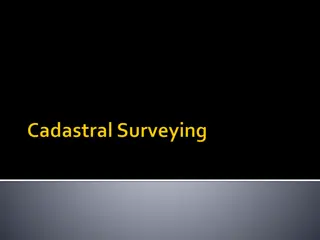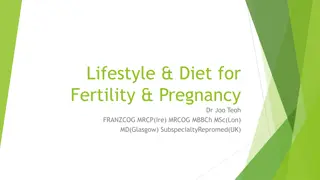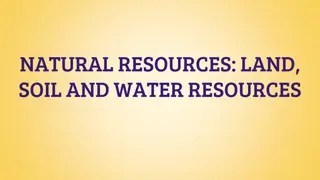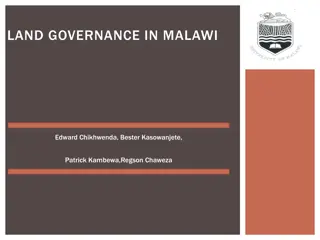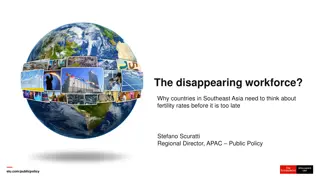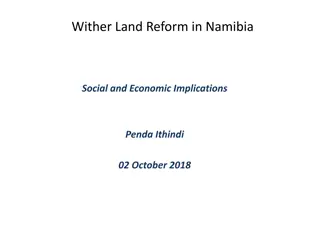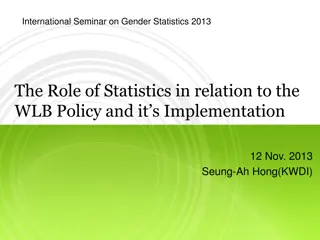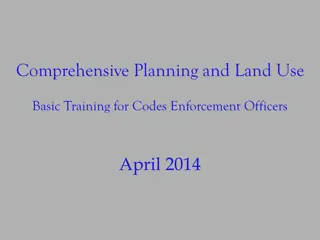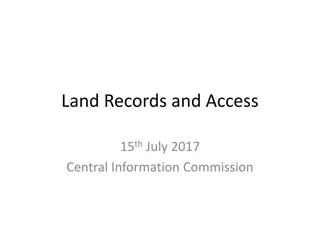Understanding Land Use Management and Its Impact on Fertility
Humans have utilized land for various needs over time, evolving from agriculture to encompass municipal, transportation, energy, recreational, and waste management. Land use management is crucial for maintaining soil fertility and preventing erosion and pollution. Factors affecting soil/land fertility include organic matter, texture, depth, nutrient content, storage capacity, reaction, and absence of toxic elements. Agriculture, the primary land use affecting soil fertility, involves techniques like fertilizers and pesticides, but may lead to erosion and nutrient loss. Effective zoning and planning are essential to mitigate environmental degradation and sustain natural resources.
Download Presentation

Please find below an Image/Link to download the presentation.
The content on the website is provided AS IS for your information and personal use only. It may not be sold, licensed, or shared on other websites without obtaining consent from the author. Download presentation by click this link. If you encounter any issues during the download, it is possible that the publisher has removed the file from their server.
E N D
Presentation Transcript
LAND use, MANAGEMENT, and its effects on fertility
Land Use Humans have been utilizing the land since the beginning of time, building settlements where there was access to water and fertile soils. Over time developments have been made in order to properly manage land use. Agriculture has been the driving force behind land use, but today there are more needs than just agriculture. Needs such as municipal, transportation, energy, recreation, and waste management.
Land Use/Management In order to use land we must know what terrain we are dealing with. Land Cover refers to the landscape. Is it forest, is it grassland, is it open water, is it mountainous, etc. Land Use shows how people use the landscape. Agriculture, municipal, mixed use, infrastructure, etc. Land cover data and mapping are major tools for land developers.
Land Uses Here are some of the General Categories for Land Use: Agriculture Residential Commercial Institutional Industrial Transportation Recreational Governmental Utility Open Space Note: Each category will have subcategories
Zoning Urban Land Use Planning is crucial to help minimize the degradation of air, water, land, biodiversity, and natural resources. Zoning is the most widely used approach. It designates certain parcels of land for certain use. What is Zoning? Philadelphia Parks and Open Space
Land Uses All categories of Land Use can contribute to erosion, pollution, and fertility problems; even open space land use if not managed correctly. Maintaining and managing the factors of soil/land fertility need to be considered for all types of Land Use.
What are the Factors of Soil/Land Fertility? soil organic matter (including microbial biomass) soil texture soil depth nutrient content storage capacity (absorption capacity) soil reaction absence of toxic elements Vermicomposting (Soil Biology and Microbiology)
Agriculture Agricultural use is the only Land Use that utilizes techniques to manage soil fertility. Agriculture uses large quantities of fertilizers and pesticides. Erosion becomes more prominent with modifying landscapes to accommodate crops. Erosion leads to loss of nutrients for soil fertility and causes water pollution due to the accumulation of sediments. Use of cover crops and conservation tilling help to maintain and improve soil fertility. Cover Cropping and Conservation Tillage
Other Land Uses Urban development typically is not focused on having fertile soil. However, it contributes drastically to the reduction of soil fertility.
References NOAA - http://oceanservice.noaa.gov/facts/lclu.html IFIA - http://www.fertilizer.org/ifa/HomePage/FERTILI ZERS-THE-INDUSTRY/What-is-soil-fertility











